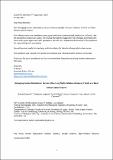Files in this item
Managing human disturbance : factors influencing flight-initiation distance of birds in a West African nature reserve
Item metadata
| dc.contributor.author | Braimoh, Bukola | |
| dc.contributor.author | Iwajomo, Soladoye | |
| dc.contributor.author | Wilson, Mark | |
| dc.contributor.author | Chaskda, Adams | |
| dc.contributor.author | Ajang, Afan | |
| dc.contributor.author | Cresswell, Will | |
| dc.date.accessioned | 2018-12-13T00:37:25Z | |
| dc.date.available | 2018-12-13T00:37:25Z | |
| dc.date.issued | 2018 | |
| dc.identifier | 251028811 | |
| dc.identifier | f4af0e2d-c00c-42bb-b6d9-aefeed34bbf5 | |
| dc.identifier | 85038093178 | |
| dc.identifier | 000424099300009 | |
| dc.identifier.citation | Braimoh , B , Iwajomo , S , Wilson , M , Chaskda , A , Ajang , A & Cresswell , W 2018 , ' Managing human disturbance : factors influencing flight-initiation distance of birds in a West African nature reserve ' , Ostrich , vol. 89 , no. 1 , pp. 59-69 . https://doi.org/10.2989/00306525.2017.1388300 | en |
| dc.identifier.issn | 0030-6525 | |
| dc.identifier.other | ORCID: /0000-0002-4684-7624/work/60426925 | |
| dc.identifier.uri | https://hdl.handle.net/10023/16678 | |
| dc.description | Thanks to the Leventis Conservation Foundation for providing full funding for this study. | en |
| dc.description.abstract | Escape behaviour in response to perceived predators can be employed as a guide when designating protected areas around sensitive bird species to minimize the impact of human disturbance. A key measure of escape response is flight–initiation distance (FID), the distance at which a prey animal initiates its escape when approached by a potential predator. We tested the predictions of optimal escape theory by determining the factors that influence FID of bird species in a Nigerian reserved area and its surrounding habitats and so the potential utility of FID in managing human disturbance on birds, for the first time within a West African context. We tested how FID varied with group size, proximity to vegetation acting as protective cover, levels of human use, and survival rate, and whether these relationships varied by species. We collected 504 FIDs for seven bird species in Amurum Forest Reserve and its surrounding habitats (Jos, Nigeria). FID was lower in larger groups and when species were closer to protective cover. FID was lower outside of the protected area because animals in sites with higher levels of human presence and use may become habituated. FID was higher for species with higher survival, being consistent with predictions from life history theory. Overall, birds perceived humans as a potential threat and responded in accordance to the predictions of optimal escape theory, with FID increasing with increased cost of staying. Reserve managers in Africa could use species and context specific FIDs to designate buffer distances for the protection of wildlife from human disturbance. | |
| dc.format.extent | 11 | |
| dc.format.extent | 628976 | |
| dc.language.iso | eng | |
| dc.relation.ispartof | Ostrich | en |
| dc.subject | Human disturbance | en |
| dc.subject | Setback distance | en |
| dc.subject | Escape distance | en |
| dc.subject | Flight-initiation distance | en |
| dc.subject | Conservation buffer | en |
| dc.subject | GF Human ecology. Anthropogeography | en |
| dc.subject | QH301 Biology | en |
| dc.subject | NDAS | en |
| dc.subject.lcc | GF | en |
| dc.subject.lcc | QH301 | en |
| dc.title | Managing human disturbance : factors influencing flight-initiation distance of birds in a West African nature reserve | en |
| dc.type | Journal article | en |
| dc.contributor.institution | University of St Andrews. School of Biology | en |
| dc.contributor.institution | University of St Andrews. Scottish Oceans Institute | en |
| dc.contributor.institution | University of St Andrews. Institute of Behavioural and Neural Sciences | en |
| dc.contributor.institution | University of St Andrews. St Andrews Sustainability Institute | en |
| dc.contributor.institution | University of St Andrews. Centre for Biological Diversity | en |
| dc.identifier.doi | 10.2989/00306525.2017.1388300 | |
| dc.description.status | Peer reviewed | en |
| dc.date.embargoedUntil | 2018-12-13 |
This item appears in the following Collection(s)
Items in the St Andrews Research Repository are protected by copyright, with all rights reserved, unless otherwise indicated.

